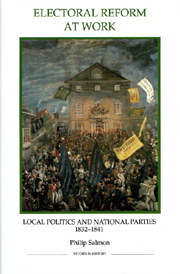Book contents
- Frontmatter
- Contents
- List of illustrations
- List of figures
- List of tables
- Dedication
- Acknowledgements
- Abbreviations
- Introduction
- PART I THE REFORMED ELECTORAL SYSTEM
- 1 Voter registration and the reformed electorate
- 2 Conservative and Liberal electoral organisation
- 3 The election after 1832: tradition and transformation
- PART II THE COUNTIES
- PART III THE BOROUGHS
- Appendices
- Bibliography
- Index
3 - The election after 1832: tradition and transformation
from PART I - THE REFORMED ELECTORAL SYSTEM
Published online by Cambridge University Press: 12 September 2012
- Frontmatter
- Contents
- List of illustrations
- List of figures
- List of tables
- Dedication
- Acknowledgements
- Abbreviations
- Introduction
- PART I THE REFORMED ELECTORAL SYSTEM
- 1 Voter registration and the reformed electorate
- 2 Conservative and Liberal electoral organisation
- 3 The election after 1832: tradition and transformation
- PART II THE COUNTIES
- PART III THE BOROUGHS
- Appendices
- Bibliography
- Index
Summary
The previous two chapters have demonstrated how the annual registration system introduced by the Reform Act transformed the business of acquiring the vote and encouraged the development of far more modern types of party organisation and electoral behaviour after 1832. Alongside these dramatic developments, however, there were obviously elements of continuity, especially in terms of the established traditions of electioneering, that also need to be taken into account. O'Gorman, in particular, has written of how ‘the carnival, the ritual, the processional and festive aspects of a campaign’ were ‘largely unhindered’ by Reform, and has argued that ‘the men, the institutions, the values, and the practices are remarkably similar each side of 1832’. Local studies, too, have drawn attention to the widespread ‘survival of pre-1832 electoral traditions’, while the continuation of bribery and corruption (of which the Reform Act itself made no specific mention), featured prominently in many earlier accounts of reformed electoral politics. As Gash's highly influential exemplar in this genre put it, ‘there was scarcely a feature of the old unreformed system that could not be found in existence after 1832’.
This chapter seeks to clarify the extent of these widely observed electoral continuities and to consider their significance after 1832. It demonstrates that even the most traditional aspects of an election were not entirely immune from the impact of Reform. Polling procedures, canvassing and campaign rituals, and, not least, the financial costs associated with electioneering became subtly differentiated from their past forms and were increasingly standardised, either through the statutory provisions of the Reform Act, or as a result of common developments on the ground.
- Type
- Chapter
- Information
- Electoral Reform at WorkLocal Politics and National Parties, 1832–1841, pp. 87 - 116Publisher: Boydell & BrewerPrint publication year: 2002



